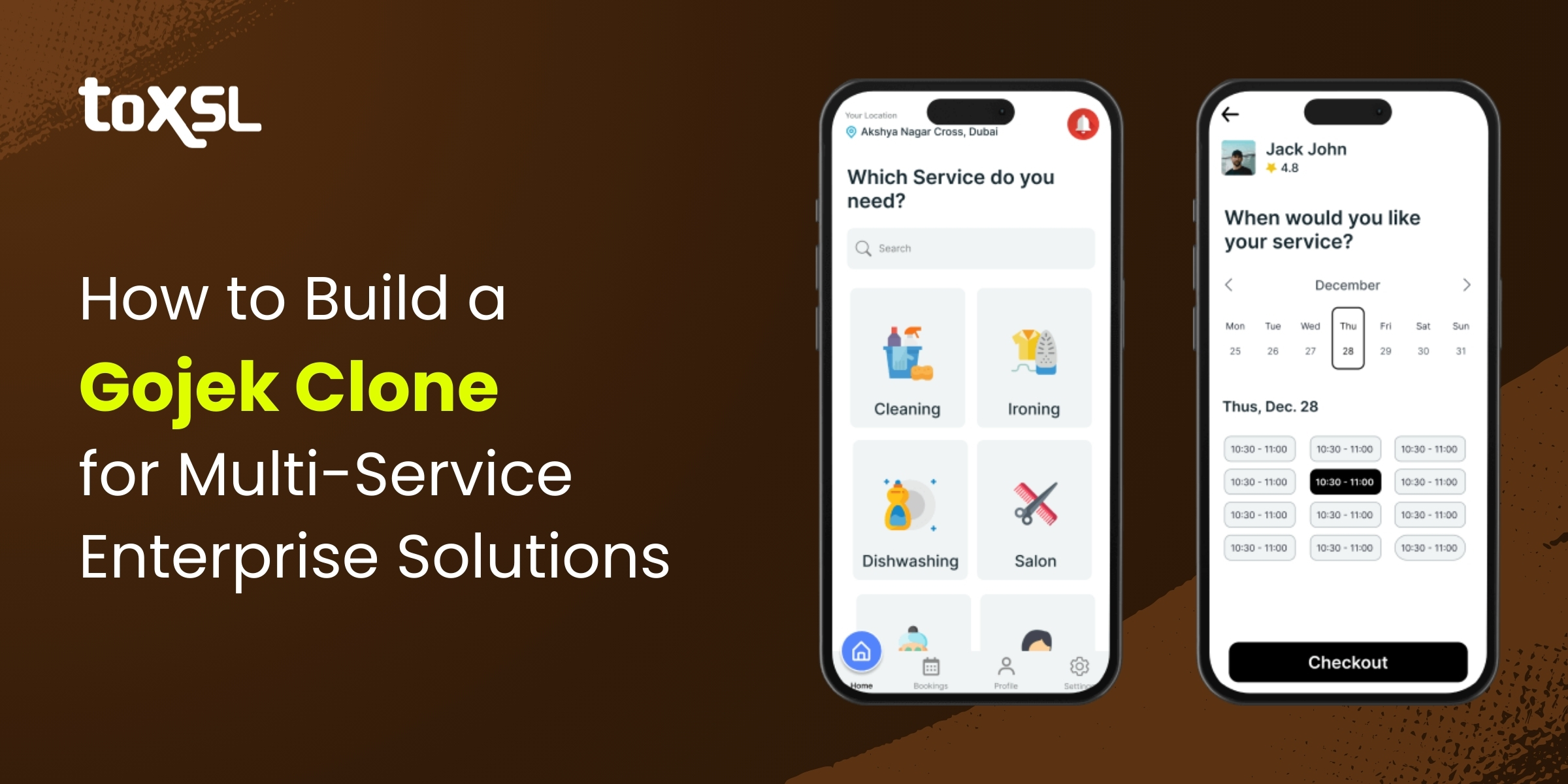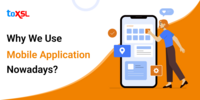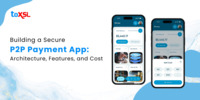- Sep 03, 2025
Share this post on:

Did you know the B2C segment is anticipated to be the fastest-growing segment in the market from 2023 to 2028? Founded on the principle of leveraging technology to remove life’s daily tasks, Gojek has become a leading multi-service platform by connecting consumers to the best providers of goods and services in the market.
Key Takeaways:
- Gojek Clone Apps are complex, multi-service platforms that combine ride-hailing, delivery, payments, and other on-demand services into one ecosystem.
- Development costs vary widely, ranging from $35,000 to over $ 72,000, depending on features, number of services, tech stack, design, and deployment.
- Core components include user and provider apps, admin dashboards, backend architecture, payment integrations, and real-time tracking features.
- Ongoing costs include maintenance, hosting, and upgrades, which should be budgeted annually for smooth operations and scalability.
- Cross-platform development (e.g., Flutter or React Native) can cut down costs by building for both iOS and Android with a single codebase.
The global multi-service market was valued at $61.3 billion in 2022 and is expected to reach $426 billion by 2030, at a CAGR of 23.9%. Wondering what is multi-service super app like Gojek? A multi-service super app like Gojek offers multiple services, including e-commerce shopping, food delivery, payments, insurance services, and other financial transactions. Because of its ability to handle so many services, it can be a complete and easy way to handle numerous parts of personal and professional life.
In addition to that, a multi-service super app is an app that allows users not only to use its main features but also to create small extra apps inside it. This kind of app, called a "super app," is connected to different platforms and systems. Let us discover more about multi-service apps and how these apps can help you empower your business and generate better revenue.
How to Develop a Multi-service App Like Gojek
Being one of the fastest-growing segments in the market, the multi-service super apps market presents several opportunities for growth and innovation. Firstly, these apps can offer more services like healthcare and education services, meeting user needs. Secondly, they can integrate innovative technologies such as artificial intelligence and blockchain to improve the user experience and enhance the security of transactions. However, multi-service apps bring a lot of benefits to the table, but building them can be an uphill battle. So, how do businesses develop a multi-service app like Gojek? In this section, we will discuss and give you a clear idea about the steps that need to be followed in order to develop a successful multi-service app like Gojek.
Step 1: Market Research and Validation
The foundation of a successful multi-service app is thorough market research and idea validation. Start by identifying the target market and understanding users’ pain points. Conduct surveys, interviews, and analyze competitor apps to gather insight into unmet user needs. This phase should answer questions like:
- Which core services should the app launch with initially?
- What platforms do your target users prefer?
- What user problems can your app solve better than competitors?
Step 2: Define Core Features and Functionality
Once research validates your idea, formally define the core features that the app must have. For a Gojek-style super app, development typically revolves around three modules: User App, Service Provider App, and Admin Panel. Each module requires carefully chosen features to ensure smooth operation.
A) User App Features:
- Easy Registration and Login: Allow users to sign up using email, phone numbers, or social media. Quick onboarding reduces drop-offs.
- Service Catalog: Displays available services with search filters and categorization.
- Real-time Location and Tracking: GPS enables users to track ride or delivery status live.
- Multiple Payment Options: Integration with credit cards, debit cards, digital wallets, UPI, etc., for easy payments.
- Ratings and Reviews: Users can rate their experience, helping maintain service quality.
- Push Notifications: Timely alerts about order status, promotions, and updates.
- In-app Support: Live chat or bot support for resolving issues instantly.
- Order History & Receipts: Allow users to view past bookings and transactions for transparency.
B) Service Provider App Features:
- Registration and Verification: Service providers upload necessary documents and get verified by admins.
- Job Requests Management: View and accept or reject incoming job requests.
- Work Scheduling: Manage availability calendars and upcoming orders.
- Navigation Assistance: GPS-enabled routes for timely deliveries or rides.
- Earnings Dashboard: Track daily, weekly, and monthly income with withdrawal options.
- Ratings & Feedback: Providers view their user ratings and customer feedback.
- In-app Communication: Chat with users or support staff for quick resolution.
C) Merchant App Features
- Merchants such as restaurants, grocery stores, and retail outlets manage their business through this app.
- Menu and Inventory Management: Add or update items, prices, and availability in real time.
- Order Handling: Receive and manage customer orders effectively.
- Promotional Tools: Run discounts and campaigns to attract more customers.
D) Admin Panel Features:
- User Management: Add, remove, and manage both users and service providers.
- Service Management: Flexibly add or retire services based on demand or new opportunities.
- Analytics & Reporting: Monitor bookings, revenue, user behavior, and app performance with dashboards.
- Payment Management: Handle commission calculations, settlements, and refunds efficiently.
- Content and Promotion: Run marketing campaigns, offer discounts, and display notifications.
- Dispute Management: Manage user complaints, cancellations, and service quality issues efficiently.
E) Additional Features
- Wallet Integration: In-app wallets for easy payments, refunds, and cashback.
- Loyalty Programs: Reward customers through points, offers, and referral bonuses.
- In-App Chat: Direct communication between users, providers, and merchants.
- Multi-Language and Multi-Currency Support: Essential for businesses targeting a global market.
Step 3: Choose the Right Technology Stack
The technology stack is the backbone of your app, impacting performance, scalability, and maintainability. For multi-service apps like Gojek, choose technologies that support rapid development, real-time communication, and high security. Use cross-platform frameworks such as React Native or Flutter to develop iOS and Android apps,Node.js with Express.js or Python with Django/Flask offers flexibility and speed.
Step 4: Design User Experience (UX) and User Interface (UI)
UI/UX Design directly impacts user retention rate. So, prioritize a clean, intuitive interface that minimizes user effort for bookings and payments. Use design tools like Figma, Adobe XD, or Sketch to create wireframes and interactive prototypes. Focus on giving users a great design experience, simplicity, speed, and transparency.
Step 5: Backend Development and Architecture
The backend development powers your app’s ecosystem, handles data, business logic, and interactions among users, providers, and admins. Opt for a microservices architecture that separates functionalities by services such as booking, payments, notifications, and user management. This modularity allows independent scaling of popular features, easier debugging and updates without downtime, and efficient load distribution.
Step 6: Frontend Development
Frontend development includes building the mobile apps for users and service providers, plus the admin web panel. Using React Native or Flutter accelerates simultaneous development for iOS and Android.
Step 7: Payment Gateway Integration
Payments are a critical layer. Integrate multiple payment options such as credit/debit cards, digital wallets, and UPI to cover user preferences. A smooth and secure payment experience improves user trust and conversion rates.
Step 8: Testing and Quality Assurance
- Before launch, extensive testing ensures the app functions effortlessly under real-world conditions.
- Functional Testing: Verify each feature behaves as expected.
- Usability Testing: Collect feedback on ease of navigation and UI intuitiveness.
- Performance Testing: Ensure the app runs smoothly under peak loads.
- Security Testing: Protect user data and payments from breaches.
- Compatibility Testing: Test across device types, screen sizes, and OS versions.
Step 9: Deployment and Launch
Deploy your backend services on reliable cloud platforms with autoscaling to handle user growth. Release mobile apps on Google Play and Apple App Store, following their submission guidelines and policies. Launch marketing campaigns to generate buzz and onboard initial users. Also, provide responsive customer support for early adopters to enhance trust.
Step 10: Post-launch Maintenance
Post-launch activities are critical for long-term success:
- Monitor real-time analytics for user behavior and app health.
- Regularly update apps for security patches, performance improvements, and new features.
- Onboard new service providers and expand service categories gradually.
- Introduce loyalty programs and referral incentives to boost user retention.
- Maintain 24/7 support and content moderation.
Cost to Develop a Multi-service App like Gojek Clone
What is the cost to develop a Gojek clone app? Multi-service apps like Gojek have revolutionized how people access everyday services by combining several offerings like ride-hailing, food delivery, payments, and more into a single platform. Developing such an app requires careful budget planning because it involves complex features, secure payment integrations, real-time tracking, and scalable architecture. In general, the cost to develop a multi-service app like Gojek ranges between $35,000 to over $72,000.
Component | Description | Approximate Cost (USD) |
|---|---|---|
Basic Features Development | Registration, booking, service listings, payments, tracking | $9,000 - $15,000 |
Advanced Features | In-app chat, ratings/reviews, multi-language support, wallet | $5,000 - $10,000 |
Cross-Platform Mobile Apps | Development for iOS and Android using React Native or Flutter | $12,000 - $20,000 |
Backend & API Development | Microservices architecture, real-time tracking, admin panel | $10,000 - $18,000 |
Payment Gateway Integration | Multi-payment options, secure transaction handling | $2,000 - $5,000 |
UI/UX Design | Wireframing, user interface, responsive experience | $3,000 - $6,000 |
Quality Assurance & Testing | Functional, security, compatibility, performance testing | $3,000 - $6,000 |
Cloud Hosting & Deployment | AWS, Google Cloud or Azure charges | $1,000 - $3,000 annually |
Maintenance & Updates | Bug fixes, feature upgrades, security patches | $2,000 - $5,000 annually |
Marketing & Launch | App store fees, initial promotion | $1,500 - $4,000 |
Multi-service Super Apps: Revenue Streams and Business Model
Multi-service super apps bundle services like ride-hailing, food delivery, payments, shopping, and more into a single platform, simplifying user experiences and enabling diverse revenue streams. Understanding their revenue model is crucial for success in this rapidly growing sector.
What Defines a Multi-service Super App?
Multi-service super apps operate as comprehensive ecosystems. They integrate diverse service verticals while providing a seamless experience through a unified interface. Features include:
- In-app digital wallets and payment systems for frictionless financial transactions.
- Embedded third-party mini-apps offering niche or specialized services.
- AI-based personalized recommendations and dynamic pricing.
- Robust platform infrastructure that supports users, service providers, advertisers, and developers in a symbiotic environment.
Revenue Streams of Multi-service Super Apps
Multi-service super apps succeed by diversifying revenue sources. The table below details the main revenue streams and elaborates on the value they bring to the platform’s ecosystem.
Revenue Stream | Description | Examples and Benefits |
Transaction Commissions | Percentage fees on transactions between users and service providers participating in the app. | Ride fares, order payments, bill settlements. |
Subscription Fees | Monthly or yearly paid plans offering premium features or enhanced services to users and vendors. | Priority bookings, ad-free interface, exclusive deals. |
Dynamic & Surge Pricing | Variable pricing during peak demand or for premium services to incentivize and balance supply. | Ride surge rates, express delivery charges. |
In-app Advertising | Targeted ads and sponsored listings by merchants and brands to promote products or services. | Featured restaurant listings, banner advertisements. |
Wallet & Financial Services | Revenue from digital wallet transactions, payment processing fees, and integrated fintech offerings. | Wallet top-ups, cross-border transfers, microloans. |
Value-added Financial Products | Loans, insurance, investment opportunities sold through the app ecosystem. | Micro-insurance, peer-to-peer lending, wealth management. |
Data Monetization & Analytics | De-identified user behavior and transaction data sold as insights to partners, respecting privacy. | Market trend reports, consumer behavior analytics. |
Business Model: The Platform Ecosystem
At their core, multi-service super apps operate as platform ecosystems that connect multiple stakeholders:
- End Users: Benefit from the convenience of accessing multiple services in one app.
- Service Providers & Merchants: Gain access to a vast, engaged customer base.
- Third-party Developers: Offer mini-apps or plug-ins that enrich the platform.
- Advertisers & Brands: Reach target consumers through personalized in-app promotions.
- Financial Institutions: Integrate banking and payment solutions within the platform.
By fostering network effects, increased user engagement attracts more service providers, creating a virtuous growth cycle that strengthens the ecosystem’s value proposition and market position.
Future Trends in Gojek Clone App
The future of Developing Multi-Service App solutions is highly promising. Here are the trends shaping the market:
AI and Machine Learning: Personalized services and predictive analytics.
Blockchain: Secure transactions and transparent record-keeping.
IoT Integration: Connecting smart devices for enhanced user convenience.
Voice Assistance: Voice-enabled commands for seamless usability.
Green Solutions: Eco-friendly ride options and sustainable delivery models.
Conclusion:
In conclusion, the global multi-service super app market is projected to grow rapidly, supported by advances in Artificial Intelligence, blockchain, and cloud infrastructure. Businesses adopting these models can unlock new revenue avenues, strengthen customer loyalty, and drive innovation in evolving digital ecosystems. Whether you’re a startup looking to disrupt the local market or an enterprise adding super app features, ToXSL Technologies can help you design, develop, and launch a powerful Gojek clone app tailored to your goals. Want to learn more? Contact us today.
Frequently Asked Questions
1. How long does it take to develop a Gojek clone app?
Typically, a full-featured multi-service app takes 6–9 months to develop. However, an MVP can be launched within 3–4 months with ToXSL Technologies' prebuilt solutions.
2. Can I build a Gojek-like app with a smaller budget?
Yes. By focusing on just 2–3 core services initially (like ride-hailing and food delivery), and using ready-made frameworks, you can build a functional MVP with a budget starting from $35,000 to $72,000+.
3. What technology stack is best for building a Gojek clone?
It depends on your goals. For scalability, a microservices architecture using Node.js, Java, or .NET for the backend, and Flutter/React Native for the frontend works well.
4. What third-party services will I need to integrate?
You will need Google Maps or Mapbox for location services, payment gateways like Stripe, Razorpay, PayPal, SMS/email services like Twilio, SendGrid, chat services like Firebase, KYC and verification APIs.
5. Is ToXSL Technologies experienced in building super apps?
Yes! ToXSL Technologies has years of experience developing multi-service apps, Gojek clones, delivery platforms, and ride-hailing solutions. We offer both custom development and ready-made frameworks to get your app to market faster and smarter.












